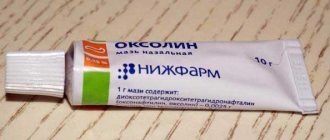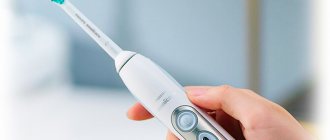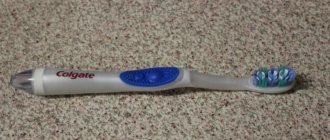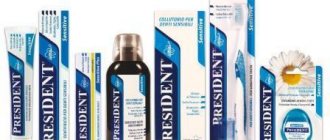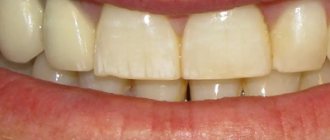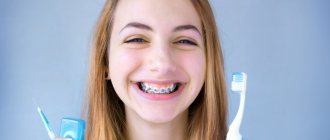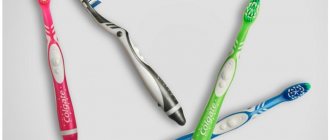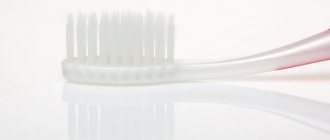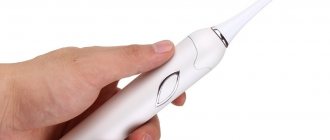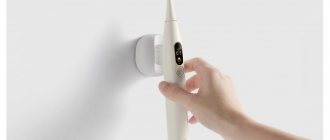Among all the devices and tools in the arsenal of a person who monitors the health of the oral cavity, there should be a floss, an irrigator or a brush, and, of course, a toothbrush, the choice of which should be treated with the utmost attention.
And the fact that the device needs to be replaced every three months is not the most important thing. The shape, structure of the bristles and many structural details of the product are of great importance.
The monotuft toothbrush occupies a special place today. This product helps not only to efficiently get rid of bacterial plaque, but also to clean the elements of orthodontic structures, which is very important in the process of forming a correct bite.
What it is?
A monotuft toothbrush differs from the classic example in its non-standard shape .
In appearance, it more closely resembles an ordinary stick, with a tuft of bristles attached to the end. A mono-tuft brush consists of an elongated thin handle and a single thin tuft of bristles located perpendicular to the handle. The functionality of the device is similar to a brush and toothpick. It does an excellent job of removing bacterial plaque along the entire length of the crown due to its full coverage of the tooth neck area.
The device can be used at any age, both with and without toothpaste. The brush has no contraindications or restrictions. The unique design does not cause difficulties during use.
Advantages of regular brushes
Although electric brushes are more technologically advanced, conventional mechanical brushes have many advantages.
- Versatile.
A manual brush, unlike an electric one, has no contraindications. Any user can brush their teeth with this tool - from the first tooth to old age, with oral diseases and absolutely healthy teeth. The main condition is to choose the right type, size of brush and stiffness of the bristles.
- Autonomous.
Mechanical toothbrushes do not need to be recharged; they can be taken with you anywhere - including on a hike, a business trip, or in transport where there is no power supply.
- Available.
The cost of mechanical toothbrush models starts from about 20 rubles, so a person with any budget can buy it.
- Easy to use.
Cleaning tooth enamel, gum surfaces, and tongue with a mechanical brush is very simple. There is a correct cleaning algorithm, following which you can efficiently remove food debris and plaque from the oral cavity, clean the interdental spaces, and remove plaque from the tongue and the inside of the cheeks. It is important to teach your child the correct technique for brushing teeth from early childhood, then he will be able to keep his mouth clean even with the help of the simplest toothbrush.
- Big choice.
Manufacturers produce thousands of models of manual toothbrushes with different stiffness and shape of bristles, size and material of the handle, with a movable and stationary head, with and without an expiration indicator. Choosing a brush with suitable functionality and design will not be difficult, because the range is truly huge.
Who invented it?
The ancient peoples of Africa can be considered the inventors of the monotuft brush . They used branches of the Miswak and Sotiu trees to clean their teeth. Thin branches were cut into small pieces, soaked in water, and then soaked on one side.
This is how the “progenitor” of the modern mono-beam brush was made. Modern manufacturers have taken advantage of the idea of their ancestors and developed a similar device, only using the latest materials and technologies.
Which manufacturers make the best toothbrushes?
The rating of manufacturers of toothbrushes with excellent quality includes dozens of items. We list several popular brands whose oral care products are known all over the world:
- Curaprox is a brand of the Swiss company Curaden, one of the world leaders in the production of toothbrushes and floss;
- Oral-B is a well-known toothbrush brand owned by Procter & Gamble. In addition to children's and adult brushes, it produces irrigators, toothpastes, flosses, rinses and other oral care products.
- Revyline is a Russian brand whose product quality is not inferior to foreign ones. It specializes in the production of irrigators, but also produces a series of functional and convenient manual brushes. All brand products were developed with the participation of leading dentists in the country.
- Apagard - this Japanese brand produces stylish brushes of the latest generation using the latest technology. For example, the manufacturer creates bristles with a tourmaline coating, which enhances the effect of the paste and improves the breakdown of plaque.
- ROCS is a brand of the Russian manufacturer DRC. The effectiveness of its products is confirmed by laboratory tests and clinical studies.
Advantages and disadvantages
Having appeared not so long ago, the mono-beam brush immediately became in demand. This popularity is due to the advantages that distinguish this product from similar products:
- high quality of crown cleaning due to the unique structure of the bristles;
- due to the easy penetration of the bristles into the gum pocket area, high-quality removal of bacterial deposits ;
- the shape of the head allows for targeted cleaning , which is very important if there are injuries and ulcerations on the mucous membrane;
- The advantage is a wide selection of bristle types and head sizes , so that the device can be used even by children;
- copes well with removing dirt from orthodontic appliances and dentures .
In addition to its advantages, this design also has some disadvantages:
- the duration of the cleansing procedure, since the head has a small area of influence;
- need to be used together with a standard brush. The monobeam option acts only as an auxiliary one .
Models and prices
Modern manufacturers offer customers various models of monotuft brushes, differing in their purpose.
Curaprox CS 1006 "Single & Sulcular"
Model with ultra-thin bristles of soft hardness, 6 mm long. The device is intended for daily use to clean plaque from each tooth and gum pockets.
The smooth surface and round shape of the cleaning head ensures hygiene that is safe for soft tissues.
The average cost of the model is 480-530 rubles.
Jordan Interbrush
Manufacturers have developed a product with a soft degree of hardness for children 6-8 years old. The brush is designed to remove plaque from gum lines and teeth.
Also, elastic bristles provide the opportunity to efficiently clean even small parts of braces.
The cost is 150 rubles.
Dentaid Vitis Monotip
The medium-firm bristles are made from clear, polished cellulose and have rounded tips to safely remove plaque from gum lines and teeth.
The device is recommended for use by patients with pathology of crowded teeth, in the presence of implants, dentures and orthodontic structures.
The manufacturer has included a special protective cap included with the brush to prevent the accumulation of bacteria on the cleaning head.
The cost of the product on the market does not exceed 200 rubles.
TePe Compact Tuft
The model is equipped with a curved neck of the head, which ensures maneuverability of the brush in the oral cavity.
The soft degree of rigidity of the bristles, 6 mm long, ensures easy removal of plaque from the surface of the enamel and in the area of the gum lines.
Manufacturers recommend using the product for consumers with healthy teeth and fixed orthodontic appliances.
The cost of the model is 320-350 rubles.
Miradent I-Prox P
The model copes well with plaque between crowded teeth and effectively cleans bridges and orthodontic structures.
The device is equipped with two types of cleaning heads, which can be located at an angle of 600 and 1200 relative to the surface of the handle.
The bristles of the product have a pointed shape to ensure better removal of plaque from teeth and interdental space.
The cost of the model is up to 300 rubles.
Edel White
The Swiss manufacturer's model was created to ensure high-quality hygiene of implants, bridges and teeth with wedge-shaped defects.
The pointed tips of the medium-hard bristles effectively eliminate plaque between the enamel and orthodontic structures.
The model includes 2 replaceable cleaning heads and a protective cap.
The cost of the set is on average 260 rubles.
The video provides additional material on the use of products and rules for brushing teeth with various pathologies.
Design features
Compared to the classic version of a toothbrush, the mono-tuft product has a smaller cleaning head and a thinner handle. Both synthetic and natural materials can be used to make the beam.
The villi, which are thin and have excellent elasticity, perfectly remove food debris, much better than dental floss and toothpick.
Each of the bristles is a collection of micro-bristles, which ensures a tight fit of the cleaning head to the enamel.
The thin handle and curved working surface make it possible to comfortably position the device in the oral cavity and allow it to penetrate into the most inaccessible places. For example, you can easily clean your wisdom teeth efficiently.
Main advantages and features
Keep in mind! This type of device has its own characteristics:
- Due to the small size and rounded shape of the head, the product easily penetrates into the most remote corners of the mouth , where it is difficult to reach with a regular brush.
- Effectively cleans the gingival margin, interdental spaces, natural pits and grooves on the teeth.
- Provides more thorough cleansing of enamel for people wearing braces, retainers, implants and other dental structures.
- Convenience and ease of use.
- No contraindications.
- Possibility of use in small children due to the small size of the head and the length of the handle.
Instructions for use
In order to get the maximum benefit from using a mono-beam brush, you need to read the detailed instructions. The teeth cleaning algorithm should consist of the following steps:
- The brush is wetted in water to ensure better glide over the enamel. If necessary, toothpaste is squeezed onto the cleaning head, however, the effectiveness of the application will not decrease if you do not use this hygiene product.
- The oral cavity should be mentally divided into 4 segments. The cleaning process begins with the most distant tooth. Making circular sweeping movements, you must follow from the gum pocket to the chewing surface.
- The cleaning head should be positioned at an angle of 450 to the side of the tooth being cleaned.
- During the hygiene process, you should not apply excessive pressure so as not to injure the soft tissues of the oral cavity.
- Attention should be paid to the outer and inner sides of the tooth, the chewing surface and the interdental space.
- The front teeth and cutting surfaces should be cleaned more intensively.
- It should take at least 10 seconds to process one unit.
See also: How to choose a wheelchair
To improve the quality of cleaning the oral cavity, it is recommended to use a monotuft brush in conjunction with the classic version.
Indications for use
The use of a monotuft brush is recommended in the absence of abnormal structural features of the dentition to prevent diseases associated with the accumulation of bacterial plaque in hard-to-reach areas of the jaw.
In addition, there are the following indications for the use of this device:
- excessive crowding of crowns , anomalies in their location, trema or diastema;
- postoperative period , characterized by sensitivity of teeth and gums;
- presence of periodontal diseases;
- wearing orthodontic appliances.
The presence of braces, bridges, implants and other systems in the oral cavity requires careful removal of plaque from their surface and tooth enamel.
A regular brush cannot fully cope with this task, so dentists recommend additionally using a mono-beam device while wearing orthodontic structures.
Selection rules
A wide range of oral care products forces the consumer to choose products according to certain selection criteria. What should you pay attention to when choosing?
Cleaning head
The cleaning head should be small and round in shape
.
Choose a head with smooth edges
to avoid injury to the oral cavity. The effectiveness of cleaning hard-to-reach areas depends on the correct size of the cleaning surface.
For children, it is recommended to use a head up to 7 mm wide. For adults, a maximum width of 11 mm is acceptable.
Hardness degree
Manufacturers offer a choice of 5 degrees of bristle hardness, each of which has its own purpose:
- sensitive (0.10 mm) – the softest bristles are created for light intensity cleaning from accumulated bacteria, and are intended mainly for children 2-5 years old and for people with increased tooth sensitivity;
- soft (0.12 mm) – soft-hard bristles affect the oral mucosa and qualitatively polish the enamel without damaging it. Recommended for pregnant women, children 5-10 years of age and people suffering from pathologies of gum tissue or periodontitis;
- medium (0.15 mm) – a medium degree of hardness is suitable for children over 10 years old, people with healthy teeth, as well as those who have superficial carious lesions;
- hard (0.17 mm) – has enhanced cleaning properties, intended for people whose teeth are prone to constant tartar formation;
- extra - hard (more than 0.17 mm) - the most rigid bristles are produced for cleaning removable braces and dentures.
The following video contains information about the advantages of monotuft toothbrushes and the rules for choosing them.
Pen
This part of the brush should be of medium thickness, ergonomic and with silicone inserts to prevent slipping during the procedure.
But the main selection criterion is the neck of the product, which must be curved to ensure a high degree of cleansing of hard-to-reach places in the oral cavity.
Bristle material
Natural and artificial materials are used to make fibers. In the first case, the pile is distinguished by significant softness and elasticity.
However, products with bristles made from natural fibers have some disadvantages:
- high cost;
- Compared to synthetic materials, short service life;
- The bristles quickly accumulate bacteria due to the flat structure of the villi.
Nylon and polyurethane are superior to natural fibers in terms of stiffness and elasticity of the bristles. But bristles made of artificial material quickly lose their shape when exposed to hot water.
For high-quality hygiene, preference should be given to brushes with bristles from 0.17 to 0.2 mm.
Number of villi
When choosing a device for a child, you should give preference to products with 700 fibers, and for an adult – 1,000 or more.
Selection Basics
The comfort and effectiveness of using a monotuft brush depends on the correctness of its choice and compliance with the specific features of the dental structure.
When purchasing a product, it is important to pay attention to the main parameters.
Product head
Its size should be small and its shape should be round.
This part of the brush should not contain chips or irregularities to avoid injury to the oral mucosa.
For adults, it is advisable to choose a brush with a head diameter of up to 11 mm; for children, this parameter should not exceed 7 mm.
Rigidity
Most monotuft brushes from various manufacturers have five hardness options:
- Sensitive – bristle thickness 0.1 mm. They do not injure the gums and enamel, so they are recommended for use in children aged 2 to 5 years and adults suffering from gum hypersensitivity and patients with thinned enamel.
- Soft – soft bristles 0.12 mm thick. They should be used by children from 5 to 10 years old and adults with diseases of the oral tissues. Devices with this type of bristles are convenient for cleaning elements of orthodontic structures.
- Medium – fibers of medium hardness with a thickness of 0.15 mm. Such devices can be used by people without periodontal problems and children over 10 years old.
- Hard – bristle thickness 0.17 mm. It is advisable to use such brushes with hard bristles in case of tartar formation.
- Extra hard – the stiffest bristles with a diameter of over 0.17 mm. Convenient devices for cleaning elements of orthodontic structures.
Bristle material
Manufacturers can use natural or synthetic bristles in their products.
The natural base is more expensive, however, it has the disadvantage that plaque can accumulate inside the hollow hair.
Synthetic fibers are more preferable for monotuft products.
Number of bristles
To effectively clean teeth, the number of bristles in a children's product must be at least 700 pieces.
For adults it should exceed 1000 pieces. In this case, the villi should be located as close to each other as possible.
Bristles length
Most models of monotuft products are made in two versions - with bristles of 6 and 9 mm.
Six-millimeter bristles are used for everyday cleaning of teeth.
To remove plaque from the surface of orthodontic structures, it is advisable to use models with a fiber length of 9 mm.
Pen
It is necessary to choose a product with an ergonomic holder that will not slip in your hand.
It is worth paying attention to the shape, thickness of the handle, the presence of protrusions and rubber pads on it.
The curvature of the neck of the product will allow easier access to all areas of the jaws.
Care
Not only your teeth need care, but also your brush itself. During its use, you should adhere to some rules:
- Each time after use, the brush must be rinsed with a stream of hot water . But do not use boiling water, as this may cause deformation of the bristles.
- At least once a week you need to treat your device with an antibacterial solution . To do this, you can use a solution of regular chlorhexidine or purchase a special product. The greatest antiseptic effect is observed after soaking the brush in the solution for several hours.
- For storage you need to use only special containers or holders . Storing in a regular glass with other brushes will lead to the accumulation of bacteria on the bristles, which can cause the risk of developing dental pathologies.
- During storage, the brush must be positioned with the head up . Thanks to this, it dries faster, which prevents the accumulation and development of microbes.
- It is imperative to change the device after using it during infectious diseases.
- Do not forget that the maximum service life of this device is 3 months . After this, it must be replaced.
See also: Climbing roses - growing secrets
Some manufacturers have equipped monotuft brushes with a special indicator that shows the degree of wear of the bristles. The lower the color saturation of the indicator, the greater the wear of the bristles.
How to carry out the procedure with braces
Wearing them determines a more thorough approach to hygiene. Food particles get clogged between the structural parts, and more plaque accumulates around. People who use this straightening method will have to brush their teeth after every meal, without exception.
Basic rules:
- Use only special products with V-shaped bristles.
- Process each element of the row separately for about 10 seconds.
- The tool must be selected in such a way that it can easily reach hard-to-reach places.
- For hygienic purposes, it is a good idea to purchase an additional irrigator or a special brush.
- After the cleaning process, use a disinfectant rinse.
Don't neglect dental floss
The bacteria that cause caries are not always accessible to removal with a regular brush. In hard-to-reach places, getting rid of them is quite difficult. Additional cleaning products must be used to clean these areas. A special thread is perfect for these purposes.
Do not use rinse immediately after cleaning
You can and should rinse your mouth with the appropriate composition at the end of the procedure. It’s just better to wait a while before using the solution. Thus, fluoride will not be washed off from the surface of the dental elements instantly, but will have time to exert its beneficial effects.
Price
The cost of a monotuft brush has a wide range from 190 to 1000 rubles . The brand of the product is of primary importance in this regard. For example, little-known brushes cost only 190 rubles .
Purchasing a similar model from the popular Curaprox will cost 800 rubles or more. The cost is also affected by the design model.
In addition to the standard sample, the market offers brushes with replaceable heads costing from 400 to 700 rubles . You can also find a double-sided model, the price of which starts from 150 rubles .
What mistakes provoke the appearance of caries?
Not all people use hygiene instruments correctly or do not take into account other important nuances of care. In order to take proper care and figure out how to brush your teeth with a toothbrush, you need to be aware of common omissions.
Long-term use of a hygiene product
Any product wears out over time, fails, and becomes unsuitable for use. If you continue to use the product after it has become unusable, it will not be possible to achieve effectiveness. Old, broken bristles are no longer able to effectively fight plaque and harmful microorganisms. Essentially, there is absolutely no benefit from such cleaning. Dental doctors recommend replacing hygiene instruments at least once every 3-4 months.
Excessive pressure on the brush
There is no need to put too much pressure on it. This aggressive treatment will not remove more plaque or bacteria. For high-quality cleaning of the oral cavity, gentle, gentle movements are sufficient. Otherwise, you will achieve only one thing - damage the gum tissue and provoke the appearance of an inflammatory process. Which, in turn, can cause the development of various diseases.
Carrying out the procedure immediately after eating
Yes, in this regard, too, not everything is simple. Experts advise waiting at least 1 hour after eating before starting cleansing. This should be remembered, especially if you ate foods containing natural acids (citrus fruits) for breakfast/dinner. The acidic environment softens the enamel layer; brushing during this period can harm the condition of the tooth enamel.
In cases where you urgently need to freshen your mouth, it is better to use plain water (rinse) or chewing gum.
Improper storage
There is no need to store personal hygiene products in a special container. In an enclosed space, pathogenic microorganisms multiply many times faster. Then all this multitude of microbes on the bristles will be transferred to the mouth. Therefore, the best option is to hold the item vertically in the open air.
Who needs a mono-tuft toothbrush?
Who do dentists recommend using these brushes to clean their teeth?
Firstly, for patients who are prescribed an orthodontic toothbrush (mainly those wearing structures on their teeth, in particular braces). If this mechanism is fixedly fixed on the teeth, then areas are formed that simply cannot be treated with a regular toothbrush. Such designs, by the way, make the gums and enamel sensitive and vulnerable.
Mono-beam brushes are much more gentle than regular brushes and will clean the tooth surface without disturbing the gums; they will remove food particles from under the braces without damaging their mechanism. You should act with careful “sweeping” movements. In this case, it is better to choose a tool with long and soft bristles.
For people wearing implants and dentures, we can recommend “Curaprox” - toothbrushes designed specifically for cleaning them. The device will be useful both for crowded teeth and for wide interdental spaces – “chapped teeth”. This brush can be used in hard-to-reach places in the oral cavity.
It will be useful for everyone as an additional effective means of dental hygiene in “difficult” places, be it molars, wisdom teeth or interdental spaces.
What types of braces cleaning products are there?
Modern specialized stores offer a large selection of all kinds of products for cleaning braces. Among them:
- Brush for braces
In practice, orthodontists use several types of toothbrushes for braces. The first type is an orthodontic brush, which has a small head (about 3 cm) and V-shaped bristles. Thanks to these design features, it easily penetrates between the arc and the groove and cleans out plaque. The second type is a brush for braces with a mono-beam structure. It can also be used to clean narrow areas between braces and the teeth themselves. Sometimes an electric brush is distinguished as one of the types of orthodontic means for cleaning braces. But in practice, it is also used by those who do not wear braces.
- Oral irrigator
An irrigator is a device with a container for water or an antiseptic solution, which is supplied through a nozzle under pressure into the oral cavity. Thanks to its gentle effect, the water jet cleans the most remote areas of the oral cavity and, at the same time, does not damage soft tissues and parts of the braces system, in particular. Manufacturers of irrigators claim that with the help of such an innovative device, teeth cleaning at home can be made almost identical to that at the dentist. In addition, with the help of an irrigator you can remove about 70% of plaque, which is twice as much as with a regular brush.
- Rinse aid
The rinse is used after the teeth and braces have been brushed. It helps maintain the normal condition of the mucous membranes of the cheeks and gums, and also prevents the development of pathogenic microflora, thanks to its disinfecting ability.
- Brush for braces
How to brush teeth with braces and how much?
How to brush teeth with braces?
Ideally, brush your teeth with braces after every meal. But this does not always work out. Therefore, you should at least rinse your mouth with water or mouthwash after eating.
You should brush your teeth at least 2 times a day in the following sequence:
- Using a regular brush and paste, we clean the surfaces of the teeth on which braces are not glued;
- Using an orthodontic brush, we carry out reciprocating movements along surfaces with “locks”;
- Use a brush to clean the spaces under the arch, above and below the braces;
- Using a mono-beam brush, we clean the outer surface of the “locks” and the surface of the tooth around each bracket;
- We use floss (dental floss) to clean the interdental spaces, and, if necessary, around the “lock”;
- Using an irrigator, we wash out the remaining “dirt” between the teeth and massage the gums.
Rules and sequence of application
It must be remembered that the monobrush is used as an auxiliary component in comprehensive oral hygiene . That is, it should be used after the usual procedure of brushing your teeth .
Stay up to date! Dentists recommend the following sequence of oral care:
- Cleaning with a regular brush;
- Using a monobeam model ;
- Using a mouth rinse;
- Treatment of interdental spaces with dental floss.
If with other points everything is simple and understandable to everyone since childhood, then cleaning the enamel with a mono-beam brush has some features:
- Before use, the bristles are moistened with water . Then you can apply toothpaste , but you can do without it.
- Treatment of the enamel surface begins with the outermost areas , gradually moving towards the center.
- itself is placed with the cleaning surface towards the teeth at an angle of about 45 degrees.
- It is necessary to make sweeping movements in a circle , directed from the gums to the cutting edge of the tooth. Avoid applying too much pressure as this can damage your gums.
- In this way, the internal and external surfaces are thoroughly cleaned , paying special attention to the interdental spaces.
- Then they move on to the chewing surface of the teeth , cleaning out all the pits and grooves. Here you can put in a little more effort.
This stage of oral hygiene increases the time spent brushing your teeth by several minutes.
Therefore, it is possible to use a monobrush only in the evening or not every day.
Rating of high-quality mono-beam toothbrushes for 2022 from
Popular models among the entire range of the company are the “Solo” cleaning brushes – “CS 1006 single” and “CS 1009 single”. They are suitable for removing plaque, cleaning braces, cleaning hard-to-reach tooth surfaces and the periodontal sulcus.
See also: How to choose bean coffee
The product is shipped from Switzerland. The body is made of plastic and has different colors, as well as the bristles, which are made of synthetics.
The difference between the two types of brushes is the size of the bristles, design and purpose. However, both designs consist of the same number of rounded fibers.
The patented bristle system creates a dense, highly effective cleaning surface. Villi absorb moisture less, compared to nylon material, and retain their cleaning properties up to 60% better.
The handle and compact head with a slight tilt in the cervical area ensure the correct position of the brush: oral care at the right angle.
Mono-tuft brushes 1006 and 1009 respectively, various design options
Product Specifications:
Name: "CS 1006" "CS 1009"
| Purpose: | removing plaque from each tooth separately | for cleaning around implants, braces, attachments |
| Hardness level: | soft | soft |
| Pile length (mm): | 6 | 9 |
| Number of cleaning elements (pcs.): | 810 | 810 |
| Head Shape: | resembles half a ball | rounded |
| Color: | any | any |
| By price (rubles): | 390 | 390 |
Curaprox Solo CS 1006 singleAdvantages:
- design;
- perfectly removes plaque from tooth enamel, especially in the gum area and joints (multi-level bristles ensure ideal cleaning);
- does not injure the gums;
- high level of wear: after several months of operation, retains its original appearance;
- ergonomic shape of the holder (comfortable).
Flaws:
- not identified.
CURAPROX CS 1009 Single & Sulcular
The monotuft model produced by Curaprox is equipped with a thousand polyester fibers 9 mm long.
Used to clean the oral cavity and parts of dental systems.
Thanks to the special coating of the fibers, the device does not scratch the enamel and does not injure the gums.
The cost of the model is 520-550 rubles.
Watch the video about the use of Curaprox mono-beam toothbrushes.
Miradent I-Prox P
Used to remove plaque from closely spaced teeth, braces and bridge structures.
The replacement head can be positioned at an angle of 60º or 120º relative to the holder.
The bristles of the head have a pointed shape for better plaque removal.
The cost of the product is 300 rubles.
Edel White
The product from a Swiss manufacturer is intended for the care of implants, bridges, as well as cleaning teeth in the presence of wedge-shaped defects.
The head with pointed bristles of medium hardness cleans the space between the enamel and the elements of the bracket system.
The set includes 2 monotuft brushes and a protective cap.
The cost of the set is 260 rubles.
TePe Compact Tuft
Equipped with a small curved head. The high density of the bristles allows you to effectively clean bacterial and food plaque from the surface of the teeth.
Dentists recommend using this product for patients with fixed orthodontic appliances.
The cost of a brush in stores and pharmacies is 320-350 rubles.
Dentaid Vitis Implant Monotip
Designed for cleaning areas of dental structures with minimal access.
The bristles of the device have medium hardness and are rounded at the ends to avoid damage to the enamel.
The cost of the product is 360 rubles.
Jordan Interbrush
Intended for use by children aged 6 to 8 years. Designed for cleaning teeth and gum lines.
Can be used to remove plaque in hard-to-reach areas of the oral cavity with installed braces.
The thin handle fits comfortably in a child's hand while brushing teeth. The cost of the product is 150 rubles.
Sources
- https://zubovv.ru/krasota-i-uxod/zubnyie-shhetki/dlya-chego-prednaznachena-monopuchkovaya.html
- https://www.vash-dentist.ru/krasota-i-uxod/zubnyie-shhetki/monopuchkovaya-podrobnoe-opisanie.html
- https://dentist-pro.ru/krasota-i-uxod/sredstva/zubnye-shhetki/chto-vybrat-klassicheskuyu-ili-monopuchkovuyu.html
- https://FB.ru/article/264639/zubnaya-schetka-monopuchkovaya—nezamenimyiy-pomoschnik-v-chistke-trudnodostupnyih-mest
- https://inwomen.ru/kak-pravilno-chistit-zuby-s-breketami-posle-edy-s-pomoshhyu-zubnoj-shhyotki-spetsialnoj-ortodonticheskoj-zubnoj-shhyotki-monopuchkovoj-shhetki-yorshikom-zubnoj-nityu- irrigatorom-dlya-polosti-rta-chto/
- https://vyborok.com/rejting-luchshih-monopuchkovyh-zubnyh-shhetok/
- https://dr-zubov.ru/krasota-i-uxod/sredstva/zubnye-shhetki/kak-ne-oshibitsya-v-vybore-monopuchkovoj.html
Did the article help you?
Andrey
Ask questions
Ask questions and write answers in the comments
How to choose a good brush
Products for the care of braces are distinguished by a special arrangement of villi, which allows them to penetrate even the most inaccessible places between the brackets and the surface of the teeth and clean out food particles and hard plaque without any problems. The brush also has a convenient shape and is easy to hold in your hands.
Important Requirements
First of all, the brush for braces must be made of hypoallergenic synthetic material, they must be soft and meet the following requirements:
- Convenient and small size.
- Hygiene.
- Safety.
Just like regular toothbrushes, this too needs to be replaced with new ones periodically. This should be done at least once every two months, but do not wait until the bristles lose their shape.

